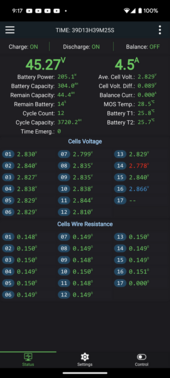So my custom build solar system + DIY Battery (16s EVE 304ah Batteries from 18650batterystore) finally started doing something concerning yesterday.
At around 14% reported SOC from JK BMS the inverter just turned off. At first I thought it was my Growatt LVM 3000 48p failing but I noticed the SOC LED Display for my JK BMS jumped to 100% before going back down to 14% before again shutting off my inverter on my Growatt hybrid (This of course when I manually restarted the inverter on my Growatt to check what was going on).
So looking at the BMS I see a Cell Volt. Diff of 0.089 so I figured my cells need balancing.

But now that I'm at near 60% SOC reported the difference is only 0.001 between cells.

The settings on my JK are to start balancing at 3.45 volts and no cell has hit that yet.
is this an indicators that my cells are bad, very different internal resistances?
Or is something else going on?
My current goal is to just fully charge the battery atm, and see if the active balancer starts balancing at all
At around 14% reported SOC from JK BMS the inverter just turned off. At first I thought it was my Growatt LVM 3000 48p failing but I noticed the SOC LED Display for my JK BMS jumped to 100% before going back down to 14% before again shutting off my inverter on my Growatt hybrid (This of course when I manually restarted the inverter on my Growatt to check what was going on).
So looking at the BMS I see a Cell Volt. Diff of 0.089 so I figured my cells need balancing.

But now that I'm at near 60% SOC reported the difference is only 0.001 between cells.

The settings on my JK are to start balancing at 3.45 volts and no cell has hit that yet.
is this an indicators that my cells are bad, very different internal resistances?
Or is something else going on?
My current goal is to just fully charge the battery atm, and see if the active balancer starts balancing at all


